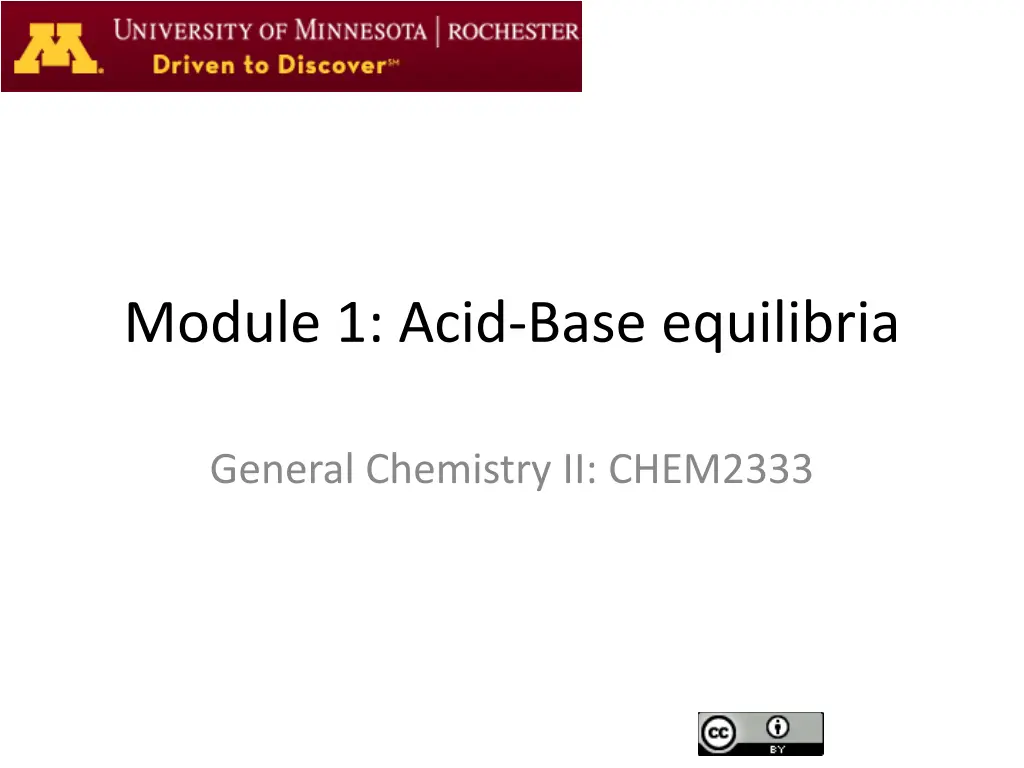
Understanding Acid-Base Equilibria in General Chemistry II
Explore acid-base equilibria in General Chemistry II with modules covering strong acids with strong bases, titration techniques, pH calculations, equilibrium constants, and important magnitudes. Learn to predict pH changes, interpret titration curves, and solve concentration problems effectively.
Download Presentation

Please find below an Image/Link to download the presentation.
The content on the website is provided AS IS for your information and personal use only. It may not be sold, licensed, or shared on other websites without obtaining consent from the author. If you encounter any issues during the download, it is possible that the publisher has removed the file from their server.
You are allowed to download the files provided on this website for personal or commercial use, subject to the condition that they are used lawfully. All files are the property of their respective owners.
The content on the website is provided AS IS for your information and personal use only. It may not be sold, licensed, or shared on other websites without obtaining consent from the author.
E N D
Presentation Transcript
Module 1: Acid-Base equilibria General Chemistry II: CHEM2333
Module 1 Module 1 Session 2 1. Video 1: Strong acids with strong bases 1. Overall reaction and ICE table: predict pH 2. Adding consecutive amounts of strong base 2. Video 2: Strong acids with strong bases 1. Graphical representation: Titration of strong acid with strong base 2. Equivalence or neutralization point. 3. pH at equivalence or neutralization point when both species are strong. 3. Video 3: Titration is a technique to determine concentration 1. Indicators 2. Problem solving: determine concentration using titration 4. Video 4: Predict the pH of acid/base mixtures (both strong) Chem 2333: General Chemistry II 2
Review. Important magnitudes to describe acid/base Relationships that you should remember what they mean Magnitudes and relationships regarding concentrations pH = -log [H3O+] pOH = -log [OH-] Kw =[H3O+][OH-] =1.0 x 10-14 pOH + pH = 14 Magnitudes and relationships regarding equilibrium constants pKa = -log Ka Ka = Kw/ Kb pKb = -log Kb pKa + pKb = 14 pKa + pKb = pKw Chem 2333: General Chemistry II 3
Strong acids with strong bases What is the pH of 0.1M 10mL of HCl solultion if we keep adding strong base NaOH 0.1M HCl + H2O H3O++ Cl- NaOH Na++ OH- Na+ + Cl- HCl + H3O++ NaOH OH- H2O + 2H2O Chem 2333: General Chemistry II 4
Strong acids with strong bases What is the pH of 10mL of 0.1M HCl solultion if we keep adding strong base NaOH 0.1M HCl + H2O H3O++ Cl- NaOH Na++ OH- Na+ + Cl- HCl + H3O++ NaOH OH- H2O + 2H2O 0 mL I: E: 5 mL I: E: 10 mL I: E: 12 mL I: E: Chem 2333: General Chemistry II 5
Strong acids with strong bases Chem 2333: General Chemistry II 6
Titration: Strong acids with strong bases Titration of 10mL of HCl 0.1M with NaOH 0.1M 10 20 Chem 2333: General Chemistry II 7
Titration: Strong acids with strong bases Draw the titration curves in each case. Identify the initial pH, the volume at the equivalence point (neutralization point) and the pH after it. a) 50 mL 0.1M HNO3titrated by NaOH 0.5M b) 20 mL 0.1M KOH titrated by HClO40.1M Chem 2333: General Chemistry II 8
Titration: Strong acids with strong bases Chem 2333: General Chemistry II 9
Titration: Strong acids with strong bases Phenolphthalein The color transition of an indicator does not necessarily have to be at the equivalence point as long as it is close to it Chem 2333: General Chemistry II 10
Titration: Strong acids with strong bases In your lab shelf, there is an unknown monoprotic acid that you need to know its identity. A way to figure out is calculating its molecular mass. You weigh 1.22g and dissolve them in 50 mL. When you titrate your unknown acid it takes 25mL of NaOH 2M to reach the equivalence point. Calculate the molecular mass. Chem 2333: General Chemistry II 11
Mixture of strong acids and strong bases Predict the final pH when we mix the following solutions. a) 100 mL 0.1M Mg(OH)2 b) 200 mL 0.05M Na(OH) c) 50 mL 0.1M HNO3 d) 300 mL 0.05M HClO4 Chem 2333: General Chemistry II 12





















